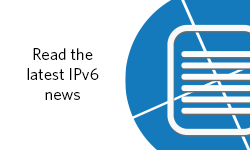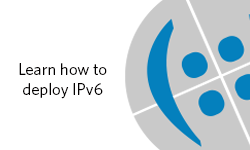
This post is co-authored by Leslie Daigle.
Approximately 15 years ago in a small hotel located in Alexandria, Virginia, United States (US), the idea for what would eventually become the two most globally significant IPv6 events was born. IPv6 was fully baked as a standard, even though the commercial hardware and services lagged, but there was still much industry discussion of ‘if’ IPv6 would be deployed, not ‘when’.
The groundwork for these global IPv6 events was started several years before planning for World IPv6 Day and World IPv6 Launch began. Organized by the Internet Society (where the co-author of this post worked at the time), the Internet operations community’s collective hope was that these would be the only true and last ever industry events required to make large-scale adoption of IPv6 a reality.
The network operator perspective
My own personal IPv6 history dates to the late 1990s. Broadband, specifically of the cable variety, was starting to take off. Data Over Cable Service Interface Specification (DOCSIS) was just being standardized, Digital Subscriber Line (DSL) was very much the dominant media to access the Internet, and Google was just being born and noticed.
The start-up I worked for specialized in enterprise network management software, and with one of the largest cable companies in the US in our backyard, we dipped our toe into the cable broadband provisioning market. The journey that followed was breakneck and chock full of industry-first scaling challenges for the Internet at the time, pre-dating the web-scale of Google, Facebook, and others.
One area of concern during this time was the need for and scarcity of publicly routable IPv4 address blocks. IPv6, which was intended to address this challenge, hadn’t been scale tested, and most — if not all — implementations were experimental and not remotely close to production-grade. The inability for IPv4 to scale to meet the needs of the networks that were experiencing explosive growth prompted (forced?) large network operators to seriously evaluate the deployment of IPv6.
The challenge was then to embark on transforming IPv6 to production-grade from the experimental implementations that were available at the time, spanning everything from network equipment to operating systems. Most daunting was the plethora of back-office applications that required proper support for IPv6 to achieve true operationalization.
The Internet growth perspective
Development of the IPv6 standard began in an age when academic and research networks still constituted a significant chunk of the global network. In that era, it was common to work out refinements of protocols at standards meetings, and then go home and implement them in the network. By the time the IPv4 address crunch was upon the global network and IPv6 was the only real answer, the Internet was a different place.
Most network operators (large and small) were commercial endeavours, stability was prized over constant evolution, equipment was deployed with an expected lifetime of years (not months), and changes had to be properly vetted before being committed. Further, the beauty of the Internet is that it is about network interconnection — each individual network operator is free to do whatever they see fit within their own networks if they follow the standards for interconnection. This allowed for many disparate networks to be connected into the global whole — but it still means that there is no ‘one size fits all’ deployment plan for new technology.
For individual network operators, deploying IPv6 was often a priority — but never the highest priority. There was always a business-critical feature deployment or a customer requirement that was higher up the list. And, because there were few customers actively engaged in demanding IPv6 support, no single network operator could simply ‘go to IPv6’ on their own. To get there, collaboration between industry competitors would be necessary.
Reliably scaling IPv6
Software that processed IPv6 implementations to the tune of 19,000 packets per second (PPS) – barely the equivalent of dial-up Internet speeds – incompatibilities between networking equipment vendors for point-to-point IPv6 interface configurations (/126 versus /127), and operating systems that became unstable when multiple router advertisements are used on a single link or Virtual LAN (VLAN) were just a few of the many examples of fundamental IPv6 implementation issues that needed to be addressed once adoption became the objective.
This was followed by DHCPv6 support for address and delegated prefix assignments, not to mention the inclusion of IPv6 support, for many access network technologies like DOCSIS and fibre to the home (FTTH). All of this was around 2005, preceding World IPv6 Day and World IPv6 Launch by six and seven years respectively.
Many service providers began their IPv6 journeys much earlier than the budding Internet firms of the time, due to the vintage and diversity of their infrastructure. However, once some of the largest broadband networks had a clear path, the content giants followed quickly. Google, YouTube, Netflix, and Facebook impressively deployed Internet-scale support for IPv6 to complement the growing number of potential broadband eyeballs that would follow. By then, the fundamental ingredients for two, not just one, global IPv6 events were in place. A collaboration between some of the world’s largest broadband and content networks — that felt like we all worked for the same company — laid the groundwork for the most substantial global IPv6 events the industry had ever seen. Beyond being poster children for Internet-style industry collaboration, deep friendships that will last a lifetime were made.
Mountains were moved leading up to World IPv6 Day, where content providers enabled IPv6 (dual-stack) by default for a single 24-hour period. The result was some much-needed data to assess what has affectionately been referred to as ‘IPv6 brokenness’. It turned out that the results were positive, but not perfect. With necessity being the mother of invention, ‘Happy Eyeballs’ was born but would not be deployed widely for the event that would follow one short year later — World IPv6 Launch.
1% was the goal for participating broadband providers. Many who participated in World IPv6 Launch achieved that goal and while others didn’t reach 1%, they laid the groundwork to pervasively deploy IPv6 in the months that followed World IPv6 Launch. Some of the greatest IPv6 achievements actually took place in the years that followed — TELUS’ impressive rollout across their mobile and fixed line broadband network, along with Facebook and their use of IPv6-only, are both rather notable examples.
No other alternatives for an open Internet
At the time of the Alexandria meeting, the end of IPv4 address allocations was within industry sight, and most technical discussions were about how networks could cope with fewer addresses than active customers at any given time. The proposed answer was Network Address Translation (NAT), specifically ‘large-scale NAT’ or ‘carrier-grade NAT’ (though some argue that the results of such NATs are not carrier-grade). Some discussion focused on how many ports would be assigned to each active user, as a means of multiplexing a single IPv4 address at any given moment in time. However, at that same point in history, content and application websites were also coming into their own, and it wasn’t at all clear that general web access would be satisfied by the number of ports network operators would be able to offer.
The needs of two industries were colliding.
Even though large-scale NAT is a factor in today’s Internet, the reality remains that it can only ever be a stop-gap measure if we expect to see continued Internet application development and evolution.
Industry shifts
The years that immediately followed World IPv6 Launch yielded continued growth with some notable spikes in adoption along the way. Generally, all who participated advanced their deployments and there were even some newcomers who deployed IPv6 at impressive rates.
Interestingly, while the industry was focused on continued incremental deployment, a shift was not so quietly unfolding that could and would shape the rate of IPv6 adoption in the years to come — the cloud. Around 2005, ‘the cloud’ meant many things to many organizations, but in many cases, it meant a purpose-built cloud infrastructure created by an organization for an organization, and not necessarily for public use. Each organization, if sufficiently motivated, could and in some cases did enable IPv6 (dual-stack) support. Sadly, in many scenarios, the underlying technology or platform did not support IPv6, resulting in roadblock after roadblock. It also turned out that developing, building, and deploying a cloud infrastructure is not for everyone. In turn, this produced a massive shift to the public cloud.
Over the past decade, there have been extraordinary shifts to move workloads to the cloud. Innovation, open source or otherwise, has fuelled a wide range of adoption. The confluence of this growth, innovation, and absence of IPv6 support, has led the industry to some new challenges and opportunities. In retrospect, the challenges of IPv4 scarcity and the absence of IPv6 are not so new.
The opportunities, however, are new. These new opportunities could inspire the completion of what the World IPv6 events started over a decade ago. The pervasive deployment of IPv6 and public cloud infrastructure serving heterogeneous customers. Further, these shifts have enabled the continued and expanded use of CDNs with the introduction of new players like Cloudflare who are, in fact, far more than a CDN. Cloudflare paved the way for ‘IPv6, on by default’ and in many ways, leads by example today.
On 6 June 2022 in Montreal, Canada, the North American Network Operator’s Group (NANOG) hosted its 85th event. It just so happened that the first day of the conference was on the 10th anniversary of World IPv6 Launch, so NANOG dedicated the day (6 June) to IPv6 content as a tribute to World IPv6 Launch. Leading with a video keynote (YouTube) from none other than the ‘Father of Internet’, Dr Vinton G. Cerf, several IPv6 oriented presentations and a panel discussion highlighting World IPv6 Launch followed. The call to action by Vint Cerf while addressing the NANOG audience was: ‘IPv6, on by default’. The audience came to learn that many of the cloud and CDN heavy hitters, namely Amazon Web Services (AWS) and Akamai, have begun enabling IPv6 by default. Unsurprisingly, Cisco Meraki is enabling IPv6 by default for their enterprise Wi-Fi management and connectivity platform.
Has the industry shift to ‘IPv6, on by default’ happened? If, so why does every data source measuring the adoption of IPv6 still continue to suggest that the transition may take upwards of 10 years, from today (2022)? The nagging question is, what remains?
Read: The transition to IPv6: Are we there yet?
Looking ahead
‘IPv6, on by default’ is not to be mistaken with IPv6-only. Outside of specific use cases, the latter will likely take a decade, or more, to materialize for consumer and/or enterprise-facing Internet connectivity. The topic of IPv6-only is for another day, another blog post, and another panel — hopefully, moderated by a new set of faces from a new set of companies.
So, what’s next? Many of the firms that started their journey or began scaling IPv6 since World IPv6 Launch are, in fact, enabling ‘IPv6, on by default’, essentially. While the ‘IPv6, on by default’ journey has begun, there is still a long road ahead to travel. Several weeks after the anniversary of World IPv6 Launch as planning continues for more content around the globe, specifically for the APNIC and RIPE regions, the following points remain unresolved:
- Operational use of IPv6 fuels usage
- Enterprise networks and IPv6
- The cost of IPv4
An in-depth analysis of IPv6 adoption clearly suggests that IPv6 use typically increases after standard corporate operating hours. Effectively, this is when people leave work and go home, where IPv6 is largely enabled by default for many and has been since before World IPv6 Launch in 2012.
There is a great deal of pent-up demand for IPv6 across some of the world’s largest enterprise networks. The cost of IPv4, coupled with yet another panel topic from NANOG 85 ‘Buying and Selling IPv4 Addresses’ (YouTube) highlights yet another fascinating intersection of topics. Can the ‘cash’ that can be realized from the sale of IPv4 addresses fuel the operational use of IPv6 and the deployment across enterprise networks? The leveraging of IPv6 to operate and deliver revenue-generating products and services could very well be a catalyst for the adoption of IPv6 across enterprise networks globally. Awareness of enterprise IPv6 was discussed in depth approaching World IPv6 Day and World IPv6 Launch, however, the task at hand — launching IPv6 for broadband and content networks to ensure we could achieve scale and reliability — was a greater priority.
Now that we have all the critical building blocks in place, are we now approaching or in the era of enterprise IPv6? Are the economic incentives finally aligning with technological readiness?
These are the topics we’ll be discussing in our next post ‘Aligning IPv6 with the Future’.
Learn more at APNIC 54
John Jason Brzozowski and Leslie Daigle will be joined by expert panellists to discuss this topic in more depth during APNIC 54.
The panel discussion World IPv6 2022 — the story behind the events at APNIC 54 will be held on Thursday, 15 September 2022 at the Grand Hyatt Singapore, with online participation for remote attendees.
John Brzozowski is a technology executive, passionate about scaling infrastructure and platforms while being obsessed with customer experience and delivering value. John is one of the original organizers of the World IPv6 series of events and has led some of the largest deployments of IPv6 globally.
Leslie Daigle is Chief Technical Officer at Global Cyber Alliance.
The views expressed by the authors of this blog are their own and do not necessarily reflect the views of APNIC. Please note a Code of Conduct applies to this blog.




